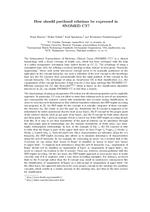How Should Parthood Relations be Expressed in SNOMED CT?
From International Center for Computational Logic
How Should Parthood Relations be Expressed in SNOMED CT?
Franz BaaderFranz Baader, Stefan SchulzStefan Schulz, Kent SpackmannKent Spackmann, Bontawee SuntisrivarapornBontawee Suntisrivaraporn
Franz Baader, Stefan Schulz, Kent Spackmann, Bontawee Suntisrivaraporn
How Should Parthood Relations be Expressed in SNOMED CT?
Proceedings of 1. Workshop des GI-Arbeitskreises Ontologien in Biomedizin und Lebenswissenschaften (OBML 2009), 2009
How Should Parthood Relations be Expressed in SNOMED CT?
Proceedings of 1. Workshop des GI-Arbeitskreises Ontologien in Biomedizin und Lebenswissenschaften (OBML 2009), 2009
- KurzfassungAbstract
We recall the re-engineering of SNOMED CT's SEP encoding as proposed in a previous paper, and then show that a backward compatible version, which also contains definitions for the auxiliary S- and P-concepts, requires an additional complex role inclusion that destroys the acyclicity property of the set of complex role inclusion. For this reason, the backward compatible reengineered version of SNOMED CT is not expressible in OWL 2, but it is expressible in EL++ and an appropriate extension of SROIQ. - Forschungsgruppe:Research Group: AutomatentheorieAutomata Theory
@inproceedings{ OBML09,
address = {Leipzig, Germany},
author = {Franz {Baader} and Stefan {Schulz} and Kent {Spackmann} and Bontawee {Suntisrivaraporn}},
booktitle = {Proceedings of 1. Workshop des GI-Arbeitskreises Ontologien in Biomedizin und Lebenswissenschaften (OBML 2009)},
title = {How Should Parthood Relations be Expressed in {SNOMED CT}?},
year = {2009},
}
